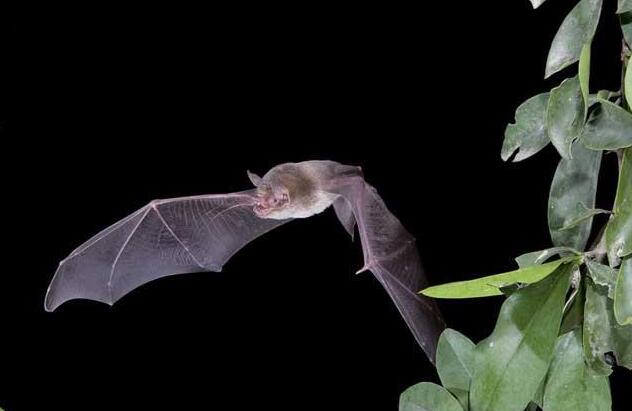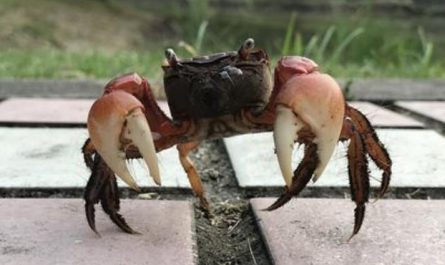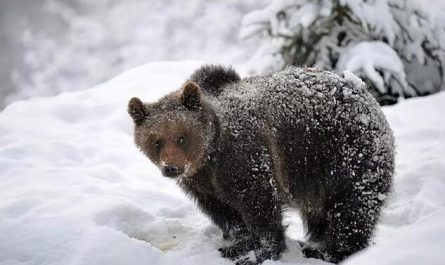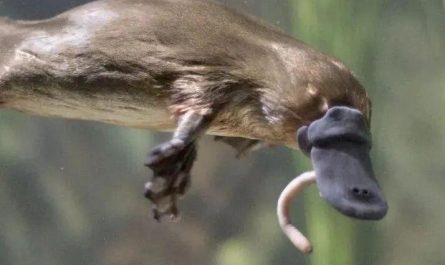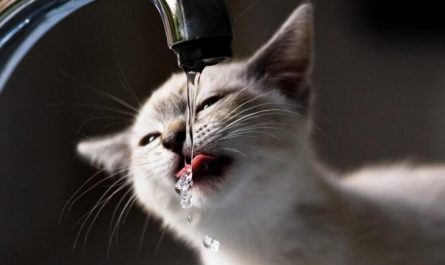The reason why bats can fly as mammals
Fossils are the best evidence. The earliest known bat fossils existed in the Eocene about 55 million years ago. At that time, the pterosaurs that occupied the sky were extinct, and bats were able to forage and survive in the blue sky. However, the appearance of these fossils is very close to the shape of bats today, and earlier bat fossils have not been found. What the ancestors of bats looked like, and how they completed their evolution is still an unsolved mystery.
However, it is not without clues. It can be inferred from the skeletal characteristics of the bat that its wings evolved from the forelimbs. The upper arms, forearms, metacarpal bones and phalanges are all very long, and they are connected by a thin and tough skin that extends to the sides, hind limbs and tail. , Forming a unique wing membrane system. The pterodactyl of a bat is strikingly similar to the extinct pterodactyl that once dominated the sky in the Mesozoic Era. In order to fly to the sky, two different types of creatures, mammalian bats and reptile pterosaurs, adopted the same evolutionary strategy.
Scientists believe that mastering the ability to fly cannot be accomplished overnight. The ancestors of bats are likely to live on trees. In order to escape predators or prey on flying insects, sometimes it is necessary to quickly move from one tree to another. As a result, during the long adaptive evolution, those individuals who have grown skins on the forelimbs to help glide in the air have gained more chances of survival. As a result of natural selection, these favorable traits have been inherited to the offspring and continuously strengthened. , Finally reborn and conquered the blue sky.
Of course, bats are not only changing their body structure, their cells are also changing. Scientific research shows that the energy required to fly in the air is 3 to 15 times that of walking on the ground. Therefore, it needs more power to fly. There is a special structure in biological cells that is responsible for supplying energy-mitochondria. In 2010, molecular zoologists Academician Zhang Yaping and Dr. Shen Yongyi discovered that the mitochondria of bats have become stronger and stronger as they evolve, indicating that their cell energy systems have also upgraded. With the omni-directional evolution of “inside and outside”, it is logical for bats to fly into the sky.
Although many bats have a fairly high flying level, their flying level is still a lot worse than that of birds, the overlord of the modern blue sky. Therefore, the disadvantaged bats try to avoid direct competition with birds during the evolution process. Most of them simply choose to go out to prey at night when there is less bird activity, and hide during the day. The bats’ wrong time to travel is the great wisdom they can survive to this day.
Life habits of bats
Hibernation habits
Bats generally have the habit of hibernation. Most hibernation places are in caves. During hibernation, their metabolism is reduced, breathing and heartbeat are only a few times per minute, blood flow slows down, and body temperature drops to the same temperature as the environment, but hibernation It is not deep, sometimes it will excrete and eat during hibernation, and it will return to normal immediately after waking up. Their fertility is not high, and there is a phenomenon of “delayed fertilization”, that is, fertilization does not occur during mating before hibernation, and the sperm spends winter in the female reproductive tract. It is only after waking up in the following spring that the mated female begins to ovulate and Fertilization, pregnancy, and birth.
surroundings
Bats live in various large and small caves, cracks, ceilings, partition walls, tree caves, and rock crevices in ancient buildings. Some southern fruit-eating bats also hide behind the leaves of palm and banana trees. Some bat populations have thousands of bats together, some male and female bats live together, and some live separately. Many bats living in the woods migrate to warm areas in winter, sometimes flying thousands of miles. Temperate cave bats generally hibernate. Bats breed only once a year, and in the earlier warm season, bats produce cubs.
Precipice Tracking
Hidden in the mountain in the southeastern part of Guangxi Zhuang Autonomous Region is a mysterious cliff with thousands of bats. The locals call it Flying Squirrel Rock. It is said that there are more than 10 million bats. Zhang Libiao, Ph.D. of Zoology, Chinese Academy of Sciences, led a team to Feishuyan for field research, hoping to reveal the secret of bats adapting to the environment through research on local bats. The bats on Flying Squirrel Rock can move on a large scale in an orderly manner, and the superior terrain of Flying Squirrel Rock forms a natural barrier for bats to avoid predators of raptors. Every September, all the bats on Flying Squirrel Rock disappear. Zhang Libiao believes that this is because the mouth of Flying Squirrel Rock is large and the temperature in winter is unstable. The bats must move to a warm place to hibernate and overwinter physiological state.
Bats vary greatly in size. The largest flying fox has a wingspan of 1.5 meters, while Kitty’s pig-nosed bat has a wingspan of only 15 cm. The color, fur texture and facial appearance of bats also vary greatly. The bat’s wings evolved from the forelimbs during evolution. Except for the thumb, the fingers of the forelimbs are extremely stretched, and there is a flying membrane from the forearm and upper arm down to the side of the body to the ankle of the lower limb. There are claws at the end of the thumb.
Most bats also have a two-layer membrane between their legs, consisting of dark, bare skin. The snout of a bat resembles a rodent or a fox. The outer ear protrudes forward and is usually very large and flexible. Many bats also have nasal lobes, which are made of skin and connective tissue, which surround or flap above the nostril. It is believed that the nasal lobe affects vocalization and echolocation.
The pectoral muscles of bats are very developed, the breastbone has keel protrusions, and the clavicle is also very developed. These are all related to its special movement mode. It is very good at flying, but it needs to rely on gliding when taking off, once it falls to the ground, it is difficult to fly again. Extend the hind legs back when flying to play a balance role.
Bats have short necks; hips and legs are long and thin. Except for the wing membrane, bats have hair all over the body, the back is in shades of gray, brown, brown or black, and the ventral side is lighter. Bats that inhabit open areas often have spots or variegated patches on their fur in a natural order, with different colors. Bats have different feeding habits, or are predatory, or help to pollinate and spread fruit, thereby affecting the natural order. Vampire bats are a serious problem for humans. The dung of insectivorous bats has been used as fertilizer in agriculture.
The ecological status of bats
Like other animals, many bats are becoming less and less in nature and tending to become extinct. Poisons and wood protection agents used to destroy insects kill them during hibernation. Many wrong ideas have also caused humans to hunt them in large numbers. Hollow trees inhabited by some species have been cut down, and the ruins have been demolished or rebuilt so that they cannot survive. Bats play a very important role in maintaining the ecological balance of nature. Various insectivorous bats can eliminate a large number of mosquitoes, noctuids, scarabs, nuns and other pests. They can prey more than 3,000 a night, which is beneficial to humans. The manure gathered by bats is also a very good fertilizer and useful for agricultural production. The processed bat droppings are called “Luminosa”, which is a kind of Chinese medicine. Bats are also important objects for studying animal orientation, positioning and dormancy. The secrets of their radiation technology have not been fully understood. Humans only know what bats can do, but still don’t know how they do it, so save those The endangered species is imperative.
Habitat destruction and fragmentation. The reduction in habitat area and the change in the spatial structure of the habitat may lead to a decline in the population: (1) The debris area may be smaller than the minimum nesting area or field area required by the bat population, or even if the debris area is large, it may cause serious damage to the population. As a result, the population in the debris is small, and the long-term survival of the population cannot be maintained; (2) The heterogeneous destruction of habitats, such as the reduction of foraging areas, which leads to population decline or extinction; (3) Crowding effect, that is, due to the living area The decrease leads to an increase in the density of certain species (such as raptors, lemurs, raccoons) in the habitat around the debris, which harms the bat population on the debris and promotes its decline; (4) Edge effect, that is, the debris is affected by the surrounding environment. An affected area is formed at the edge of the debris, which gradually reduces the area of the debris, which is extremely detrimental to the bat population in the debris; (5) The isolation effect is mainly manifested in the impact on the hibernation period of bats, due to the isolation between the habitat and the hibernation area The inability to carry out normal hibernation, resulting in population decline.
Man-made direct interference factors. Bats often live in caves, abandoned mineshafts and tree caves, but also under the eaves, in the pavilions and bell towers of old churches. Mining, closing old mines or dumping garbage, urban construction, and improper woodland clearing (cutting down dead trees used by bats as habitats) will cause bats to have no shelter and cause a large number of deaths. Similarly, waking up hibernating bats will make them run out of fat prematurely and die of starvation before spring arrives. This poses a great threat to the maintenance and growth of bat populations. The use of durable insecticides is also a major threat to them. Toxins accumulated in bats can affect the development of the larval nervous system. Large-scale larval death will have a serious impact on the population. After more than ten years, the affected population will still be difficult to recover.
Improper hunting. In tropical areas, such as Guam, big bats are not only eaten by locals, but also exported to other islands in the Pacific. Bats on the island, especially those with unique geographical and narrow distribution, are very threatened. Intentional killing is also a problem. Superstition causes people to kill bats, thereby reducing the number of bats. People’s control of vampire bats and bats that are confirmed to be harmful to crops killed not only the problematic bats, but also other bat species that shared their habitats.
Habitat microclimate changes. The change of habitat temperature is very important for bats, especially for female bats and juvenile bats in late lactation, because their body temperature regulation ability is very weak. In the summer of 1974, the cold weather extended the growth period of the larvae of Myotis sodalis in Indiana, USA by two weeks, and delayed the completion of migration by three weeks, which affected the winter fat storage The amount, leading to a large number of bat deaths. In addition, the habitat microenvironment determines the abundance of insects. When the microenvironment is not suitable for insect growth, bats will die due to lack of food.
